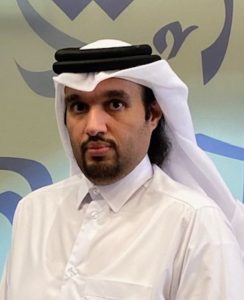
Dr. Mohammed Al-Sada, assistant professor at our department, and his team has been awarded a Qatar-Japan Research Collaboration (QJRC) cycle2 grant for the project titled: “A Versatile Telexistence System with Implicitly Assistive Telemanipulation Capabilities”.
QJRC, funded by Marubeni, brings together Qatar University and Japanese Universities to collaborate on research topics of mutual interest and develop high-quality, high-impact outcomes and prototypes that benefit both parties. QJRC paves the way for sustainable cooperation and helps, in a concerted manner, to fulfill the knowledge-based economy aspiration of Qatar.
The project’s team includes:
– LPI: Mohammed Al-Sada, Qatar University, Doha, Qatar.
– LPI: Prof. Tetsuya Ogata, Waseda University, Tokyo, Japan.
– PI: Prof. Tatsuo Nakajima, Waseda University, Tokyo, Japan
– PI: Dr. Osama Halabi, Qatar University, Doha, Qatar.
– PI: Dr. Faisal Al-Jaber, Qatar University, Doha, Qatar.
– PI: Dr. Sarada Prasad Dakua, Hamad Medical Corporation, Doha, Qatar
– PI: Dr. Pin-Chu Yang, Waseda University, Tokyo, Japan
– PI: Mr. Abdulla Iskandar, Waseda University, Tokyo, Japan
– PI: Mr. Naoki Hashimoto, Waseda University, Tokyo, Japan.
– Consultant: Dr. Yamen Saraiji, Sony AI, Tokyo, Japan.
Here is the project’s abstract:
In recent years, Qatar has faced pressing challenges in knowledge exchange and collaboration with the world across industrial and educational sectors. In response to such challenges, we fabricated a wearable telexistence system that can be used for knowledge transfer and remote collaboration tasks as part of QJRC-1. This proposal builds upon our system by addressing its key limitations through two main objectives. First, we propose a novel robot formfactor that enables the wearable robot to dock into a mobile robotic platform, that we called the Yorishiro system. This system provides stability, power, and enables using the robot in three Modes: i) Wearable Telexistence Mode: the robot is a fully worn system. ii) Augmented-Wearability Mode: the robot is worn by a surrogate user while attached to the Yorishiro System. iii) Mobile Telexistence Mode: the robot is completely independent from surrogate users and is a fully mobile system. Therefore, the Yorishiro system significantly increases the reliability and stability of the robotic system, and extending its usage and deployment domains for industrial and medical contexts.
The second objective is concerned with increasing the efficiency and accuracy of telemanipulation task by developing an implicitly assistive telemanipulation system for telexistence (ATX). Our ATX system mainly focusing on helping the robot operator to grasp tools with consideration to their affordances through deep learning based detection and motion generation method. ATX implicitly assists users by compensating operational errors during telemanipulation, thereby maintaining embodiment over the robot that is necessary to telexistence. The contributions of these objectives are significant, as we explore efficient novel formfactors for telexistence systems, and integrate assistive methods to ensure operational efficiency of the robot. To the best of our knowledge, these objectives have not been explored in any previous research, and advance the state of the art in telexistence systems.
